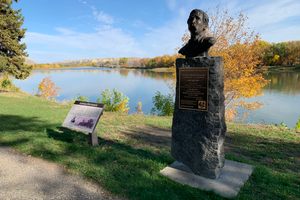“Officially” speaking, a total of four U.S. governors have ever been assassinated. The first, Charles Bent, was killed in a local uprising in 1847 against U.S. military occupation of the newly conquered territory of New Mexico. Edwin McCook, governor of the Dakota Territory, was murdered in 1873 by a man angry that McCook wouldn’t loan him money to buy a cigar. In 1900, William Goebel was shot the day before he was sworn in as governor of Kentucky. Lastly, former governor of Idaho Frank Steunenberg was killed in 1905 by a bomb potentially planted at the behest of a miners’ labor union.
But there might actually be a fifth. On a summer night in 1867, while still acting governor of the Montana Territory, Thomas Francis Meagher fell off a steamboat into the Missouri River, his body never to be recovered. To this day, nobody is sure why he fell. Theories include that he was drunk, committed suicide, or was disoriented from illness. But the most intriguing hypothesis was that he was murdered.
Meagher’s life story was an extraordinary one. Born and raised in Ireland, he took part in the failed Young Irelander Rebellion of 1848, for which he was convicted of sedition and sentenced to death. After public outcry, his sentence was commuted to a lifetime of exile in Tasmania. Less than three years later, he escaped to the United States, where he became a citizen, began publishing a weekly newspaper, and studied law. At the outbreak of the U.S. Civil War in 1861, Meagher enlisted in the Union and eventually became a brigadier general. President Andrew Johnson rewarded him for his service in 1865 by appointing him Secretary of the Montana Territory, where he also served as acting governor.
Territorial Montana in the 1860s was a violent place, filled with highway robbers and murderous vigilante groups. In his short time there, Meagher made many enemies with his pro-Irish stance and support for a representative form of government. The most notable incident was when Meagher ordered that James Daniels, a fellow Irishman, be released from prison after being convicted of manslaughter by a court without jurisdiction. A prominent vigilante group responded by hanging Daniels that very night, the release order still in his pocket. The head of that group, Wilbur Sanders, was Meagher’s biggest ennemy, having threatened his life before. It just so happens that Sanders was present in Fort Benton the day Meagher drowned.
But Meagher was also a heavy drinker, and he had been sick with dysentery the week of his death. Had he stumbled to the ship’s railing to puke, from drink or illness, or both, a small slip could have been all that was needed to send him overboard. But then again, maybe his weakened state was the perfect time for his enemies to get rid of him.
Today, a memorial with a bust and a plaque can be found beside the river near where Meagher met his end. Looking at the peaceful and placid water, it’s hard to believe this is the same river where a plunge meant probable death. The Missouri River, once fierce and unpredictable, has been tamed by billions of dollars’ worth of dams and reservoirs. Montana’s era of roving settler-murderer groups has also ended. If anybody ever truly knew what happened to Meagher, they too have now slipped into the past, taking the story with them.


